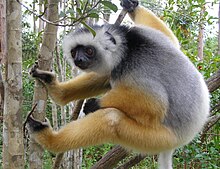Lemurs
| Lemurs | ||||||||||||
|---|---|---|---|---|---|---|---|---|---|---|---|---|

Black and White Vari ( Varecia variegata ) |
||||||||||||
| Systematics | ||||||||||||
|
||||||||||||
| Scientific name | ||||||||||||
| Lemuriformes | ||||||||||||
| Gray , 1821 |
Lemurs ( Lemuriformes , from Latin Lemures "shadow spirits of the deceased" and forma "shape") are a sub-order of the primates . They belong to the group of wet-nosed monkeys , formerly assigned to the half-apes . According to today's perspective, the taxon comprises around 100 species .
Lemurs are found only on Madagascar and smaller islands nearby. They are a very diverse group in terms of body shape and lifestyle. Most species live on trees and are herbivores or omnivores.
Many representatives are threatened in their existence by the destruction of their habitat. Some genera, such as the giant lemur , have become extinct in the last two millennia.
The name is inspired by the Roman ghosts of the dead Lemures because of their often nocturnal way of life, their large eyes and therefore distinctive faces .
features

The lemurs are a diverse group. The weight of the mouse lemur varies from 30 grams - the Berthe mouse lemur is the smallest primate of all - to the Indri , which can reach 10 kilograms. Extinct forms such as Archaeoindris were significantly larger and weighed up to an estimated 200 kilograms. A sexual dimorphism in terms of weight is only weak, the males and females are roughly the same size. The differences in the size of the canine teeth that occur in numerous other primates are not found in lemurs. However, in some species of the Great Makis ( Eulemur ) the sexes differ considerably in terms of fur color. In most species, the tail is as long as the body or longer, only the Indri is almost tailless. In the more recent species the legs are always longer than the arms, only in the extinct Palaeopropithecinae and Megaladapidae it was the other way round. For those lemurs that move four-legged through the branches, the difference is only slightly pronounced. In the representatives, who climb and jump vertically, the legs are significantly longer than the arms, for example in the weasel lemurs and many Indri-like . All fingers and toes have nails with the exception of the cleaning claw on the second toe, which is found in all wet-nosed monkeys .
The length of the fur is variable, its color also varies and can range from white through various gray and brown tones to black. The more diurnal lemurs like some Sifakas or common Makis can also be colorful. The face is often hairless, sometimes tufts of ears or beard-like hairs on the cheeks or chin are present.
The head shape is variable; In addition to lemurs with a rounded head, there are also species with an elongated, dog-like snout, such as the varis . The eyes are relatively large, especially in the nocturnal species, and provided with a tapetum lucidum (a light-reflecting layer behind the retina ). As with all wet-nosed monkeys, the nose is equipped with a nasal mirror , which ensures a well-developed sense of smell . The upper lip is divided by a cleft called the philtrum . The shape and number of teeth is variable depending on the diet, the tooth formula is I 0-2 / 1-2 C 0-1 / 0-1 P 1-3 / 0-3 M 3/3. Modifications in the teeth of the lemurs are the missing incisors of the upper jaw in weasel lemurs and the extinct Megaladapidae as well as the loss of one incisor per half of the jaw in the lower jaw of the Indri-like .
distribution and habitat
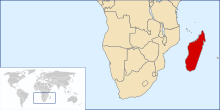
The natural range of the lemurs is the island of Madagascar off the east coast of Africa. Two species, the Mongozmaki and the Brown Maki , were also introduced to the Comoros .
In the past, the animals were widespread across the island, today they are restricted to the forests in the coastal regions and are absent in the unforested areas such as the central highlands. Less than 10% of the island's area remains untouched to such an extent that it can serve as a habitat for these animals, so that today the lemurs only live on an area of 50,000 to 60,000 km².
Most lemurs live in forests, although they live in different forest types. They occur in the dry deciduous forests of the west coast and the thorn forests of the southwest as well as in the rain forests of the east coast. Only the ring-tailed lemur can assert itself to a greater extent in unforested savannah and mountain regions. The extinct species of lemurs presumably used a greater variety of habitats; so Hadropithecus could have lived mainly in grasslands.
Way of life
Movement and activity times

The species living today, with the exception of the semi- terrestrial ring-tailed lemur (some of which live on the ground), are tree-dwellers that come to the ground only occasionally. They have developed several patterns of locomotion, mainly vertical climbing and jumping and four-legged walking (arboreal quadruped). The extinct lemurs were found to be more diverse: there was the Palaeopropithecinae, which were probably sloth-like hanging on the branches, the koala-like slowly climbing or hopping Megaladapidae or the giant sloth-like Archaeoindris , for which there are no analogies among the other primates.
The lemurs probably evolved from nocturnal ancestors and to this day the majority of lemur species have retained this activity pattern. Most nocturnal species build leaf nests to sleep or retreat to tree hollows, thickets or other hiding places. However, some species have adapted to a diurnal lifestyle, including the Indri, the Sifakas and the Varis. There are also species with a cathemeral way of life, that is, without a fixed day-night rhythm, which can be active over the entire 24-hour cycle. This can depend, for example, on the season and the associated food supply and the weather. This flexible cathemerality found in several species of Common Makis is otherwise unknown in primates.
As with other mammals, the activity time of the lemurs roughly correlates with body size: the smaller species are exclusively nocturnal and usually weigh less than 1 kilogram. In contrast, the larger species are mostly diurnal or cathemeral. The three diurnal genera mentioned above are also the largest living lemurs.
In order to deal with the seasonally fluctuating food supply, especially in western Madagascar, the lemurs have developed some strategies that are unique to primates. The tail of the fat- tailed lemur and, to a lesser extent, the mouse lemur acts as a fat store. In the rainy season they eat more food, which allows them to gain weight significantly, and store fat in their tails, in the dry season, which is less nutritious, they then feed on these reserves. At this time, they often fall into a brief torpor (rigid state) in order to save energy. The fat-tailed lemurs are the only primates that keep a prolonged hibernation , a hibernation-like state during the dry season. The body temperature is not kept at a stable level, but fluctuates with the outside temperature, the metabolic rate drops significantly and the animals can lose half their weight during this time.
Social behavior and communication

The social structures of the lemurs are variable, but hardly known for many species. In general, however, as with primates in general, a high degree of social behavior can be observed, there are no strict loners. In the case of nocturnal species, it is often the case that the range of a male overlaps that of several females. Sometimes even several animals sleep together in one shelter during the day, but search for food separately. There are also monogamous species in which a male and a female live in family groups and often stay together for years. It is known of at least one species, the western fat-tailed lemur , that although it lives in monogamous groups, the females often cheat and the offspring are not only conceived by the male with whom they live.
Still other species live in larger groups with several adult males and females as well as the young. These groups are often dominated by females, which is evident, among other things, from the fact that the females determine the routes of the daily forays and have preferred access to food sources. In these mixed groups, competition between males outside of the mating season is often weak. Other social structures known from other primates, such as male-dominated mixed groups or even harem groups, in which a male gathers several females around him, are not known in the lemurs.
Lemurs often inhabit fixed territories , which at least at the edges can overlap with those of other groups, the core areas are often exclusively inhabited by one group. The olfactory sense of these animals is very well developed compared to that of the dry-nosed monkeys , and communication with scents is accordingly important. They are mainly used to mark the grazing areas. For example, various lemur species have anal glands , glands on the chest, in the crook of the arm and on the wrist. In the males of some species, the wrist glands are provided with spines with which they can scratch branches or trees and at the same time provide them with fragrances. Verbal communication also plays an important role: sounds are used, among other things, to mark the territory, to maintain or establish contact with group members or to warn of predators - some lemur species even have different sounds to avoid birds of prey or predatory mammals warn about the ring-tailed lemur. The communication with postures and facial expressions hardly plays a role in the nocturnal species, in diurnal or cathemeral species such as the ring-tailed lemur, several forms of communication through gestures and grimaces were observed. In the social interaction of many lemurs, mutual grooming also plays an important role.
nutrition

The diet of the lemurs is variable, they are either omnivorous or pure herbivores . There are lemurs that mainly eat fruit - such as numerous common makis, leaf-eaters such as weasel lemurs and many indri-like lemurs, as well as lemurs, which are adapted to the consumption of tree sap . For some species, nectar is an important addition to the diet, and buds, leaves and other parts of the plant are also often eaten. They also eat carnal food to varying degrees, mainly insects , spiders , millipedes and other invertebrates, sometimes small vertebrates and bird eggs. Even within a species, the composition can vary considerably depending on the habitat, and there are often significant seasonal differences.
The structure of the teeth reflects the various specializations, and there are also other morphological adaptations, for example the enlarged appendix of the leaf-eating weasel and bamboo lemurs or the elongated tongue of the nectar-eating varis.
Reproduction
The reproduction of most lemur species is strongly seasonal and is linked to the climatic conditions of Madagascar. Most births occur at the end of the dry season , in the period from September to December, so that the young animals can spend their critical first months of life in the time of the greatest food supply. Depending on the length of the rainy season, some species can have a second peak of birth around February. The seasonality of reproduction is so strong that in some species, such as some mouse lemurs , the females are only ready to conceive for a few hours within a year.
The gestation period varies between 90 and 170 days, the litter size between one and three. Unlike many dry-nosed monkeys, there are numerous species in which twin births predominate. In many nocturnal lemurs, the newborns spend their first weeks of life in a leaf nest and are later placed in a sheltered place by the mother while they are looking for food and later picked up again. In other species, the mothers carry their offspring around with them, first on their belly, and later let them ride on their backs. After a few months, the young are weaned.
Lemurs and humans
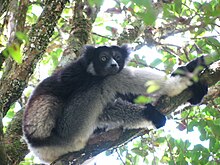
In culture
Some species of lemurs have found their expression in Malagasy cultures. Indris were considered sacred animals that worshiped the sun - they can often be seen sunbathing. This view completely protected them from hunting until recently, similarly to the Sifakas. In western culture, the ring-tailed lemur is the best-known species of lemur and a symbol of its home island.
threat
Most of the lemur species are threatened. The reasons for this are, on the one hand, the destruction of their habitat by slash and burn , deforestation , charcoal production and mining . In addition, there is hunting, especially for the larger species - the taboo regulations that protected some species have often ceased to exist due to the weakening of traditions and relocations. In 2020 the IUCN listed 33 species and thus around a third of all lemur species as critically endangered ; a total of 103 species are considered endangered or endangered. There are already many projects in place to stop the deforestation of the rainforest. But widespread poverty and an unstable political system mean that the forest continues to be illegally cleared. In the animal kingdom, the lemurs are particularly threatened by the fossa , Madagascar's largest predator, birds of prey and feral domestic dogs.
Extinction of the giant lemurs

Since humans came to Madagascar around 1,500 years ago, at least eight genera and at least 16 species of lemurs have become extinct there. These include the Palaeopropithecinae , the Archaeolemurinae and the genera Megaladapis and Pachylemur . All extinct species were believed to be diurnal and larger than the species living today. Most of the subfossil remains of these animals are between 2500 and 1000 years old, there is another report from the 17th century that could apply to any larger species of lemur. The finds come not only from the coastal areas, but also from the now unforested central highlands. It is unclear to what extent human settlement activity is responsible for the disappearance of the forests. The forest stocks of Madagascar have fluctuated strongly in the last millennia, the extent of the grasslands in central Madagascar is not exclusively due to humans.
The most likely reason for the extinction of the larger lemur species is considered to be hunting by humans. The extinct species were probably easy hunting targets due to their slowness and size and profitable prey due to their amount of meat. In addition, as with many other large mammals, a slow rate of reproduction and a low population density may have occurred. In general, large animals living on islands are particularly at risk from sudden human hunting, as examples from other islands, such as New Zealand , show. In addition to the giant lemurs, other Malagasy animals, such as elephant birds and the Malagasy hippos , became extinct around the same time .
Systematics
External system

The lemurs form together with the Loris (Lorisidae) and Galagos (Galagonidae), which are summarized as Lori-like (Lorisiformes), as well as the finger animal the group of wet-nosed monkeys (Strepsirrhini). The term half-monkeys is no longer used today, as the goblin lemurs , which were also included in the past, are more closely related to the (real) monkeys .
Whether the lemurs are a monophyletic group, that is, descended from a common ancestor, or whether there were several colonies of Madagascar by primates and thus the lemurs do not form a natural family group, has long been disputed. The two most problematic taxa in this context were on the one hand the finger animals, which deviate strongly from the other representatives in terms of shape and show some convergent developments to the rodents , and on the other hand the cat lemurs, whose physique resembles that of the Lori-like and those with this group also the regression the internal carotid artery , the internal carotid artery. There was speculation that the finger animals could be the sister group of all remaining wet-nosed monkeys, and they were led in a separate suborder, chiromyiformes.
However, the molecular genetic findings clearly indicate that the lemurs - and also the Lori-like - are monophyletic, which was confirmed by subsequent investigations. However , there are hardly any morphological features for this monophyly. The most striking feature is the structure of the ear region : in the lemurs the ectotympanicum (the ring-shaped bone on which the eardrum is stretched) is grown around the bulla tympanica and is not visible from the outside, in the loric-like it is fused with the side wall of the bulla and visible from the outside.
The position of the lemurs in the family tree of the primates is expressed in the following cladogram:
| Primates (Primates) |
|
||||||||||||
|
|
Internal system
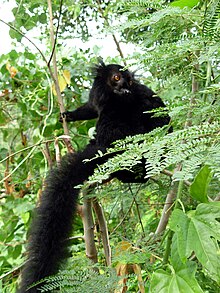

The number of known species has increased significantly in recent years. In 1999, 31 living species were differentiated; due to several new descriptions and the increase from populations previously listed as subspecies to independent species, 97 living species were distinguished in 2008.
The following list shows the system down to the genre level :
-
Cat lemurs (Cheirogaleidae)
- Fork-striped lemurs ( Phaner ): four types
- Fat- tailed lemurs ( Cheirogaleus ): nine species
- Tussock lemur ( Allocebus trichotis )
- Giant mouse lemurs ( Mirza ): two types
- Mouse lemurs ( Microcebus ): 24 species
- Lepilemuridae
- Weasel lemurs ( Lepilemur ): 26 species
- Megaladapidae †
- Megaladapis †: three types
-
Common Makis (Lemuridae)
- Varis ( Varecia ): two types
- Pachylemur †: two types
- Katta ( lemur catta )
- Great Makis ( Eulemur ): twelve species
- Bamboo lemurs or half lemurs ( Hapalemur ): six species
- Great bamboo lemur ( Prolemur simus )
-
Indriiformes (Indriidae)
- Subfamily Indriinae
- Woolly lemurs ( Avahi ): nine types
- Sifakas ( Propithecus ): nine species
- Indri ( Indri indri )
- Subfamily Palaeopropithecinae (Sloth Lemurs) †
- Mesopropithecus †: three types
- Babakotia †
- Palaeopropithecus †: two species
- Archaeoindris †
- Subfamily Archaeolemurinae (baboon lemurs) †
- Archaeolemur †: two types
- Hadropithecus †
- Subfamily Indriinae
The division of the living representatives into five families is morphologically and genetically well established, but the parentage relationships have not been fully clarified. The finger animals (Daubentoniidae) are without a doubt the sister group of all other lemurs.
A possible cladogram of the lemurs looks like this:
|
|
|
||||||||||||||||||||||||||||||||||||||||||||||||||||||||||||||||||||||||||||||||||||||||||||||||||||||||||||||||||||||||||||||
|
|
evolution
Speciation
In Madagascar, seven ecological zones can be distinguished, which differ considerably in terms of climate and vegetation , and which are each populated by appropriately adapted lemur species. Here an allopatric speciation has taken place. In some areas, however, up to ten lemur species live at the same time, which form different ecological niches . The large number of species is therefore due to an additional sympatric speciation . Regardless of the question of the area of origin of their common ancestors, today's lemurs, as monophyletic taxons, are examples of adaptive radiation .
Origin of the lemurs
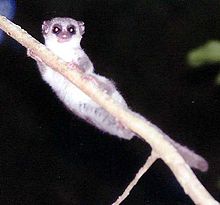
The question of how the lemurs got to Madagascar has not yet been fully clarified. Since they are a monophyletic group, only a single colonization process can be assumed. Several hypotheses have been proposed as to how the animals could have reached the island, which is 400 kilometers off the African coast today: on the one hand, via a land bridge ( land bridge hypothesis ) that might have existed during a drop in sea level, on the other hand, via small islands ( "Island hopping") and, thirdly, on floating vegetation. According to calculations with the help of the molecular clock , the development of the lemurs on Madagascar can be proven 47 to 54 million years ago, i.e. from the Eocene .
In the 19th century the idea of a land bridge between India and Madagascar was raised to explain the existence of wet-nosed monkeys in the two countries, Philip Sclater named the hypothetical continent Lemuria . There is no evidence of a previous existence of land bridges or island chains between Madagascar and the Indian subcontinent . Rather, the land masses of Africa, Madagascar and the Indian subcontinent were once connected to one another in a southern continent of Gondwana (see also plate tectonics ).
The most plausible hypothesis for immigration after the parts of the Gondwana have drifted apart is the sea route on floating vegetation. Such a transport would have presented a great challenge for the animals. They should have survived for a long time without food and drinkable water and had to arrive in a group in which there were also reproductive partners. For animals in torpor or hibernation , such a trip would have been most likely to survive. Among the lemurs there are some representatives that significantly reduce their metabolic rate during hibernation and spend their inactivity phase cuddled together in a tree hollow. It is conceivable that the ancestors of the lemurs had a similar way of life at the time of a transport. Other Malagasy mammals also have low metabolic rates or hibernate, for example the Malagasy predators or the tenreks , which would suggest a similar history of settlement.
The ancestors of lemurs but could have been located in Madagascar, as in India , which during the time of the southern continent Gondwana with Australia, Madagascar and Africa connected was, fossil proven lemurs were displaced from other mammals, while in Madagascar no competing species of mammals lived and the lemurs therefore formed many ecological niches comparable to the adaptive radiation of the marsupials in Australia.
literature
- Nick Garbutt: Mammals of Madagascar. A Complete Guide. Yale University Press, New Haven CT et al. a. 2007, ISBN 978-0-300-12550-4 .
- Thomas Geissmann : Comparative Primatology. Springer-Verlag, Berlin a. a. 2002, ISBN 3-540-43645-6 .
- Russell A. Mittermeier , Jörg U. Ganzhorn, William R. Konstant , Kenneth Glander, Ian Tattersall , Colin P. Groves , Anthony B. Rylands , Andreas Hapke, Jonah Ratsimbazafy, Mireya I. Mayor, Edward Louis jr, Yves Rumpler, Christoph Schwitzer , Rodin Rasoloarison: Lemur Diversity in Madagascar. In: International Journal of Primatology. 29, 2008, ISSN 0164-0291 , pp. 1607-1656
- Ronald M. Nowak: Walker's Mammals of the World. 6th edition. Johns Hopkins University Press, Baltimore MD 1999, ISBN 0-8018-5789-9 .
Web links
Individual evidence
- ↑ Mittermeier et al .: Lemur Diversity in Madagascar. 2008
- ↑ Geissmann: Comparative Primatology. 2002, p. 75
- ↑ Geissmann: Comparative Primatology. 2002, pp. 38-39
- ↑ N. Schwensow, J. Fietz, KH Dausmann and S. Sommer: MHC-associated mating strategies and the importance of overall genetic diversity in an obligate pair-living primate. In: Evol Ecol, 2007, doi: 10.1007 / s10682-007-9186-4 .
- ^ Joseph M. Macedonia: The vocal repertoire of the ringtailed lemur ( Lemur catta ). In: Folia Primatol 61 (4), 1993, pp. 186-217.
- ↑ edgeofexistence.org: Indri ( Indri indri )
- ↑ Garbutt: Mammals of Madagascar. 2007, p. 146
- ↑ Almost a third of lemurs and North Atlantic Right Whale now Critically Endangered - IUCN Red List , IUCN press release of July 9, 2020, accessed July 11, 2020.
- ↑ Nowak: Walker's Mammals of the World. 1999, p. 524.
- ↑ Geissmann (2003), p. 71.
- ↑ Geissmann: Comparative Primatology. 2002, p. 71; Garbutt: Mammals of Madagascar. 2008, p. 85.
- ↑ Don E. Wilson, DeeAnn M. Reeder (Ed.): Mammal Species of the World . A Taxonomic and Geographic Reference. 3. Edition. Johns Hopkins University Press, Baltimore 2005, ISBN 0-8018-8221-4 .
- ↑ a b A. D. Yoder: Phylogeny of the lemurs. In: The Natural History of Madagascar (edited by SM Goodman and J. Benstead), University of Chicago Press, 2003, pp. 1242-1247.
- ↑ C. Roos, J. Schmitz, H. Zischler: Primate jumping genes elucidate strepsirrhine phylogeny. In: Proceedings of the National Academy of Sciences. 101, 2004, p. 10650, doi: 10.1073 / pnas.0403852101 .
- ↑ Geissmann: Comparative Primatology. 2002, 42-43.
- ↑ Geissmann: Comparative Primatology. 2002, p. 19
- ↑ Nowak: Walker's Mammals of the World.
- ↑ Mittermeier et al .: Lemur Diversity in Madagascar.
- ↑ for living species: Mittermeier et al .: Lemur Diversity in Madagascar. ; for genera from extinct after Nowak: Walker's Mammals of the World.
- ↑ James P. Herrera and Liliana M. Dávalos. 2016. Phylogeny and Divergence Times of Lemurs inferred with Recent and Ancient Fossils in the Tree. Systematic Biology (2016). doi: 10.1093 / sysbio / syw035
- ↑ Handouts for teaching biology, upper level, complete volume. Cornelsen Verlag 2009. ISBN 978-3-464-17184-4 . Page 292–293
- ↑ Geissmann: Comparative Primatology. 2002, p. 47.
- ↑ Archived copy ( Memento of the original dated May 30, 2013 in the Internet Archive ) Info: The archive link was inserted automatically and has not yet been checked. Please check the original and archive link according to the instructions and then remove this notice. Early Jurassic , Ron Blakey
- ↑ Archived copy ( memento of the original from January 22, 2016 in the Internet Archive ) Info: The archive link was automatically inserted and not yet checked. Please check the original and archive link according to the instructions and then remove this notice. Early Cretaceous , Ron Blakey
- ↑ Handouts for teaching biology, upper level, complete volume. Cornelsen Verlag 2009. ISBN 978-3-464-17184-4 . Page 292–293
